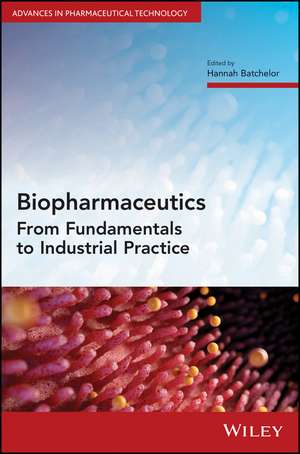Biopharmaceutics – From Fundamentals to Industrial Practice: Advances in Pharmaceutical Technology
Autor H Batcheloren Limba Engleză Hardback – 19 ian 2022
Explore the latest research in biopharmaceutics from leading contributors in the field
In Basic Biopharmaceutics, distinguished researcher Hannah Batchelor delivers a comprehensive examination of the tools used within the field of biopharmaceutics and their applications to drug development. This edited volume is an indispensable tool for anyone seeking to better understand the field of biopharmaceutics as it rapidly develops and evolves.
Beginning with an expansive introduction to the basics of biopharmaceutics and the context that underpins the field, the included resources go on to discuss how biopharmaceutics are integrated into product development within the pharmaceutical industry. Explorations of how the regulatory aspects of biopharmaceutics function, as well as the impact of physiology and anatomy on the rate and extent of drug absorption, follow.
Readers will find insightful discussions of physiologically based modeling as a valuable asset in the biopharmaceutics toolkit and how to apply the principles of the field to special populations. The book goes on to discuss:
- Thorough introductions to biopharmaceutics, basic pharmacokinetics, and biopharmaceutics measures
- Comprehensive explorations of solubility, permeability, and dissolution
- Practical discussions of the use of biopharmaceutics to inform candidate drug selection and optimization, as well as biopharmaceutics tools for rational formulation design
- In-depth examinations of biopharmaceutics classification systems and regulatory biopharmaceutics, as well as regulatory biopharmaceutics and the impact of anatomy and physiology
Perfect for professionals working in the pharmaceutical and biopharmaceutical industries, Basic Biopharmaceutics is an incisive and up-to-date resource on the practical, pharmaceutical applications of the field.
Preț: 730.17 lei
Preț vechi: 802.39 lei
-9% Nou
139.74€ • 145.35$ • 115.36£
Carte tipărită la comandă
Livrare economică 12-26 aprilie
Specificații
ISBN-10: 1119678285
Pagini: 320
Dimensiuni: 165 x 269 x 24 mm
Greutate: 0.71 kg
Editura: Wiley
Seria Advances in Pharmaceutical Technology
Locul publicării:Chichester, United Kingdom
Descriere
Explore the latest research in biopharmaceutics from leading contributors in the field
In Basic Biopharmaceutics, distinguished researcher Hannah Batchelor delivers a comprehensive examination of the tools used within the field of biopharmaceutics and their applications to drug development. This edited volume is an indispensable tool for anyone seeking to better understand the field of biopharmaceutics as it rapidly develops and evolves.
Beginning with an expansive introduction to the basics of biopharmaceutics and the context that underpins the field, the included resources go on to discuss how biopharmaceutics are integrated into product development within the pharmaceutical industry. Explorations of how the regulatory aspects of biopharmaceutics function, as well as the impact of physiology and anatomy on the rate and extent of drug absorption, follow.
Readers will find insightful discussions of physiologically based modeling as a valuable asset in the biopharmaceutics toolkit and how to apply the principles of the field to special populations. The book goes on to discuss:
- Thorough introductions to biopharmaceutics, basic pharmacokinetics, and biopharmaceutics measures
- Comprehensive explorations of solubility, permeability, and dissolution
- Practical discussions of the use of biopharmaceutics to inform candidate drug selection and optimization, as well as biopharmaceutics tools for rational formulation design
- In-depth examinations of biopharmaceutics classification systems and regulatory biopharmaceutics, as well as regulatory biopharmaceutics and the impact of anatomy and physiology
Perfect for professionals working in the pharmaceutical and biopharmaceutical industries, Basic Biopharmaceutics is an incisive and up-to-date resource on the practical, pharmaceutical applications of the field.












